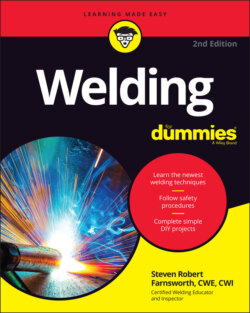Читать книгу Welding For Dummies - Steven Robert Farnsworth - Страница 62
Protecting yourself from electric shock
ОглавлениеMost welding equipment uses some sort of electrical power, so electric shock is a very real risk in the welding trade. Electric shocks can cause injury, death, fires, and explosions; here are a few tips to keep in mind in an effort to keep your risk for electric shock at an absolute minimum.
Don’t allow electrode holders to touch wet gloves or wet skin.
When using extension cords, be sure to plug the power tool you’re using into the extension cord before plugging the extension cord into the wall outlet. Then be sure you unplug the extension cord before you unplug the power tool.
Be sure your extension cords don’t have kinks, knots, or nicks. Inspect your cords before you use them (every time), and get rid of the cord immediately if you notice damage.
If a cable or cord feels hot to the touch when you’re using it, discontinue use right away. The heat means that the cord isn’t big or heavy duty enough for the amount of electricity you’re using, and that can be very dangerous.
If any of the power tools or extension cords you’re using has a three-pronged plug and is missing one of the prongs, don’t use the tool or cord under any circumstances.
Keep all power tools and cords dry at all times.
If your power tools have worn or broken parts, repair or replace the broken parts immediately.
If your power tools have keys, chucks, or wrenches attached to them, be sure to remove those items before plugging in or using those tools. They can create a hazard if they’re still inserted when the power tool starts moving or spinning.
If a power tool’s housing is cracked, don’t use it.
Make sure you provide a ground for any electric tool or device that requires grounding. (Read tool and equipment instructions thoroughly to determine whether you need to provide a ground.)
